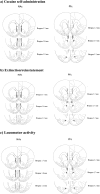Effects of intra-accumbal or intra-prefrontal cortex microinjections of adenosine 2A receptor ligands on responses to cocaine reward and seeking in rats
- PMID: 30426181
- PMCID: PMC6267142
- DOI: 10.1007/s00213-018-5072-8
Effects of intra-accumbal or intra-prefrontal cortex microinjections of adenosine 2A receptor ligands on responses to cocaine reward and seeking in rats
Abstract
Rationale and objectives: Many studies indicated that adenosine via its A2A receptors influences the behavioral effects of cocaine by modulating dopamine neurotransmission. The hypothesis was tested that A2A receptors in the nucleus accumbens (NAc) or the prefrontral cortex (PFc) may modulate cocaine reward and/or cocaine seeking behavior in rats.
Methods: The effects of local bilateral microinjections of the selective A2A receptor agonist CGS 21680 or the A2A receptor antagonists KW 6002 and SCH 58261 were investigated on cocaine self-administration on reinstatement of cocaine seeking.
Results: The intra-NAc shell, but not intra-infralimbic PFc, administration of CGS 21680 significantly reduced the number of active lever presses and the number of cocaine (0.25 mg/kg) infusions. However, tonic activation of A2A receptors located in the NAc or PFc did not play a role in modulating the rewarding actions of cocaine since neither KW 6002 nor SCH 58261 microinjections altered the cocaine (0.5 mg/kg) infusions. The intra-NAc but not intra-PFc microinjections of CGS 21680 dose- dependently attenuated the reinstatement of active lever presses induced by cocaine (10 mg/kg, i.p.) and the drug-associated combined conditioned stimuli using the subthreshold dose of cocaine (2.5 mg/kg, i.p.). On the other hand, the intra-NAc pretreatment with SCH 58261, but not with KW 6002, given alone evoked reinstatement of cocaine seeking behavior.
Conclusion: The results strongly support the involvement of accumbal shell A2A receptors as a target, the activation of which exerts an inhibitory control over cocaine reward and cocaine seeking.
Keywords: Adenosine A2A receptor ligands; Cocaine seeking; Cocaine self-administration; Local microinjection; Nucleus accumbens; Prefrontal cortex; Rats.
Conflict of interest statement
The authors declare that they have no conflict of interest.
Figures








References
MeSH terms
Substances
Grants and funding
LinkOut - more resources
Full Text Sources
Medical
Miscellaneous

